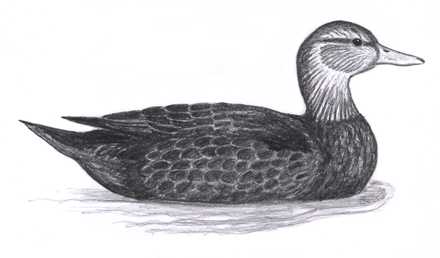
Last week some brave woman named Janet, from Falmouth, wrote in asking about one of our most common species of waterfowl, the Mallard. She was concerned that this handsome bird was not getting the proper respect, because of its abundance and habit of living in city parks. Or something like that. If you need to know anymore, you’ll have to dig through the recycle pile and find last week’s paper, because that’s about all that I can remember.
True wild Mallards are hardy wary birds that have no use for people and their hand outs. They are strong flyers, bursting straight out of the water like a missile, without having to run along the water like many sea ducks. Mallards are able to reach flight speeds of over 50 MPH migrating south as the northern ponds freeze up.
The problem is that not all Mallards are wild. Mallards are very easy to breed in captivity. For years people have raised them for food, as pets or to kill with guns. And, of course, many of the ducks, hoping to avoid the roasting pan, went AWOL the minute no one was looking. These escapees, called feral, do not have the migration instincts that the wild ducks have. Even when winter moves in, they don’t go very far, they just hang around looking for open water and whatever food they can find.
Most feral ducks, that avoided the roasting pan, ended up being meals for the truly wild predators. Yet, somehow some survived to breed in the spring. These are the “drainage ditch” ducks that you mentioned last week. These are the trashy birds that will stalk you while you try to picnic in the park. They are the ducks that cause pollution by coming to the same beach everyday to beg food from well meaning people. These also are the ducks that are happy to crossbreed with just about any other species of duck. Thus creating an odd creature that looks more like its father was Steven King, instead of a Mallard.
There is another more serious problem that Mallards have been causing in recent years. Just as in the situation above, this problem, too, is related to humans altering the balance, only this time it’s the wild Mallards that are causing the problems. Changes to the traditional breeding grounds have caused the wild Mallards to move into the breeding grounds of the American Black Duck. The results could possibly mean the end of black duck.
Black ducks are very common here on Cape Cod. Both the male and the female black duck are generic looking brown birds, that resemble the female Mallard. Without splashy colors, black ducks are largely ignored by most people who don’t hunt. Still, they are an important part of our environment landscape. But who knows for how much longer?
Days ago, when we started this endless Mallard hurrang, I mentioned that many species of wild ducks may be direct descendants of Mallards. Black ducks seem to be one of those species. Being closely related has led to interbreeding between the black ducks and the Mallards. When drake Mallards move into an area, they easily out compete the duller male black ducks. With one look at the Mallard’s flashy green heads and sly smile, the black duck babes are all over them.
Usually when different species interbreed, their freaky looking offspring are sterile, so that is the end of that. But black ducks and Mallards are so closely related that their kids are totally fertile and ready to breed with the best of them. And since there are many more Mallards then black ducks, the Mallards could be slowly displacing the black ducks throughout their entire range.
I like Mallards, too. But whatever is going on, good or bad, the fault is not with the Mallards, it is those who changed the ecosystem that are to blame.
Sorry this answer was so long Janet (Is your name still Janet?) and at times got a little dry. I don’t know about you, but I could use a glass of something to wash all of this boring talk down. Perhaps a nice glass of Cold Duck.